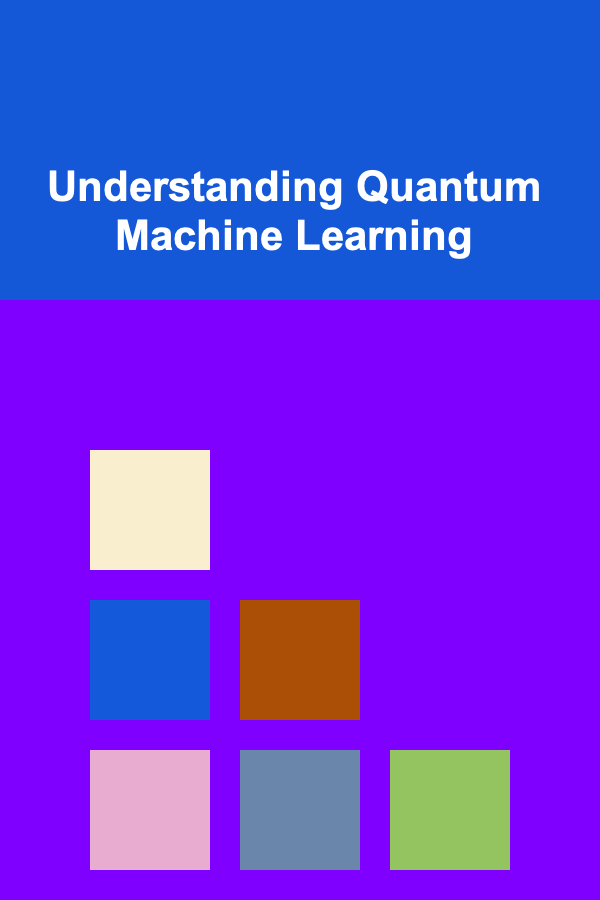
Understanding Quantum Machine Learning
ebook include PDF & Audio bundle (Micro Guide)
$12.99$9.99
Limited Time Offer! Order within the next:

Quantum Machine Learning (QML) is a rapidly evolving field that sits at the intersection of quantum computing and machine learning. It leverages the principles of quantum mechanics to enhance and potentially revolutionize various machine learning tasks. While still in its nascent stages, QML holds the promise of solving complex problems that are intractable for classical computers, leading to breakthroughs in areas like drug discovery, materials science, financial modeling, and artificial intelligence.
The Motivation Behind Quantum Machine Learning
Classical machine learning has achieved remarkable successes in numerous domains, driven by increasing computational power and vast datasets. However, certain limitations remain. Specifically, training complex models on massive datasets can be computationally expensive and time-consuming. Furthermore, some problems inherently involve complex data structures and relationships that classical algorithms struggle to efficiently capture. This is where the potential advantages of quantum computing come into play. Quantum computers offer fundamentally different computational capabilities based on phenomena like superposition, entanglement, and quantum interference, potentially leading to exponential speedups for certain types of machine learning algorithms.
The core motivation behind QML is therefore twofold:
- Speedup: Quantum algorithms may offer exponential speedups compared to their classical counterparts for specific machine learning tasks, allowing us to tackle previously unsolvable problems.
- Improved Performance: QML may enable the development of more powerful machine learning models that can better capture complex data patterns and relationships, leading to improved accuracy and generalization performance.
Fundamental Quantum Concepts
Understanding QML requires a grasp of some fundamental concepts from quantum mechanics:
Qubit: The Quantum Bit
Unlike classical bits, which can only represent 0 or 1, a qubit can exist in a superposition of both states simultaneously. This is represented mathematically as:
|ψ⟩ = α|0⟩ + β|1⟩
Where:
|ψ⟩represents the state of the qubit.|0⟩and|1⟩are the basis states, corresponding to classical 0 and 1.αandβare complex numbers called amplitudes, satisfying the normalization condition|α|^2 + |β|^2 = 1.|α|^2represents the probability of measuring the qubit in the state|0⟩, and|β|^2represents the probability of measuring it in the state|1⟩.
This superposition allows qubits to explore a much larger state space compared to classical bits, enabling quantum algorithms to perform computations on multiple possibilities concurrently.
Entanglement: Interconnected Qubits
Entanglement is a unique quantum phenomenon where two or more qubits become linked together in such a way that the state of one qubit instantly influences the state of the other, regardless of the distance separating them. Entangled qubits exhibit strong correlations that are not possible in classical systems. This correlation is crucial for many quantum algorithms, allowing them to perform complex computations in a highly interconnected manner.
A simple example of an entangled state (Bell state) is:
|Φ+⟩ = (1/√2)(|00⟩ + |11⟩)
In this state, if we measure the first qubit and find it to be |0⟩, we instantly know that the second qubit will also be |0⟩, and vice-versa. This instantaneous correlation is the essence of entanglement.
Quantum Gates: Manipulating Qubits
Quantum gates are the building blocks of quantum circuits. They are unitary transformations that manipulate the state of one or more qubits. Analogous to classical logic gates (AND, OR, NOT), quantum gates perform operations on qubits. However, unlike classical gates, quantum gates are reversible, meaning that the original state can be recovered from the transformed state.
Some common quantum gates include:
- Hadamard Gate (H): Creates a superposition state. Applied to
|0⟩it produces(1/√2)(|0⟩ + |1⟩)and to|1⟩produces(1/√2)(|0⟩ - |1⟩). - Pauli Gates (X, Y, Z): Single-qubit gates that perform rotations around the x, y, and z axes of the Bloch sphere, respectively. The X gate is also known as the NOT gate because it flips the state of the qubit.
- Controlled-NOT Gate (CNOT): A two-qubit gate that flips the target qubit if the control qubit is in the state
|1⟩. - Phase Gate (P): Applies a phase shift to the
|1⟩state.
Quantum Measurement: Extracting Information
Measurement is the process of extracting information from a quantum system. When a qubit is measured, its superposition collapses into one of the basis states (|0⟩ or |1⟩) with a probability determined by the amplitudes α and β. This measurement process is inherently probabilistic, meaning that repeated measurements of the same qubit may yield different results. This probabilistic nature is a key aspect of quantum computing and is used to implement certain machine learning algorithms.
Quantum Machine Learning Algorithms
QML encompasses a range of algorithms that leverage quantum mechanics to enhance or accelerate machine learning tasks. Here are some prominent examples:
Quantum Support Vector Machines (QSVM)
Support Vector Machines (SVMs) are powerful classical machine learning algorithms used for classification and regression. QSVM leverages quantum computers to perform the computationally intensive kernel evaluation step more efficiently. By encoding data into quantum states and using quantum circuits to calculate kernel functions, QSVM aims to achieve exponential speedups over classical SVMs for certain datasets.
The key idea is to use a quantum feature map φ(x) to map classical data points x into a high-dimensional Hilbert space. The kernel function then becomes:
K(x, y) = |⟨φ(x)|φ(y)⟩|^2
A quantum computer can estimate this inner product much faster than a classical computer, particularly for complex feature maps. The remaining steps of the SVM algorithm (optimization, classification) can then be performed classically.
However, it's important to note that the practical advantage of QSVM depends heavily on the specific dataset and the chosen quantum feature map. Currently, the size and capabilities of available quantum computers limit the applicability of QSVM to relatively small datasets.
Quantum Principal Component Analysis (QPCA)
Principal Component Analysis (PCA) is a dimensionality reduction technique that identifies the principal components (directions of maximum variance) in a dataset. QPCA leverages quantum algorithms to speed up the computation of the eigenvectors and eigenvalues of the covariance matrix, which are essential for PCA. The HHL algorithm (named after Harrow, Hassidim, and Lloyd) is a key subroutine used in QPCA to solve systems of linear equations exponentially faster than classical algorithms. This speedup can be significant for high-dimensional datasets.
The basic idea is to encode the covariance matrix Σ into a quantum state and then use the quantum phase estimation algorithm to extract its eigenvalues. The corresponding eigenvectors can then be prepared using a quantum state preparation circuit.
While QPCA offers a theoretical exponential speedup, the practical implementation faces challenges due to the complexity of the quantum circuits and the limitations of current quantum hardware. Furthermore, the cost of encoding the data into quantum states can be significant.
Quantum k-Means Clustering
k-Means clustering is a classical unsupervised learning algorithm used to partition data points into k clusters based on their proximity to cluster centroids. Quantum k-Means aims to speed up the distance calculation step, which is the most computationally intensive part of the algorithm, by leveraging quantum algorithms for distance estimation.
The quantum algorithm typically involves encoding the data points into quantum states and using quantum circuits to estimate the distance between them. This distance information is then used to update the cluster centroids iteratively, similar to the classical k-Means algorithm.
While quantum k-Means offers a potential speedup, the overall performance depends on the specific data distribution and the efficiency of the quantum distance estimation algorithm. Like other QML algorithms, it faces challenges related to quantum hardware limitations and data encoding costs.
Quantum Neural Networks (QNNs)
Quantum Neural Networks (QNNs) are a broad class of models that combine the principles of quantum computing and neural networks. There are several different approaches to building QNNs, including:
- Variational Quantum Circuits (VQCs): These are parameterized quantum circuits that are trained using classical optimization algorithms. The parameters of the quantum circuit are adjusted to minimize a cost function that reflects the desired task (e.g., classification, regression). VQCs are often used for near-term quantum devices (NISQ) because they can be implemented with relatively shallow circuits.
- Quantum Boltzmann Machines (QBMs): These are quantum analogs of classical Boltzmann machines, a type of probabilistic neural network. QBMs leverage quantum mechanics to model complex probability distributions and can be used for tasks like feature learning and generative modeling.
- True Quantum Neural Networks: These are hypothetical neural networks where both the nodes and connections are quantum mechanical. While still largely theoretical, these networks hold the potential for significant advantages over classical neural networks in terms of computational power and representational capacity.
Variational Quantum Circuits (VQCs)
VQCs are a popular approach to QNNs due to their suitability for near-term quantum hardware. They consist of a parameterized quantum circuit, a classical optimizer, and a cost function.
- Data Encoding: The input data is encoded into the quantum circuit. This can be done using various encoding schemes, such as amplitude encoding, angle encoding, or basis encoding.
- Parameterized Quantum Circuit: A quantum circuit with adjustable parameters (e.g., rotation angles of quantum gates) is applied to the encoded data. This circuit transforms the initial quantum state into a new state that represents a feature representation of the input data.
- Measurement: The quantum state is measured, and the measurement results are used to calculate a cost function.
- Classical Optimization: A classical optimization algorithm (e.g., gradient descent) is used to adjust the parameters of the quantum circuit to minimize the cost function. This process is repeated iteratively until the cost function converges to a minimum.
VQCs offer a flexible framework for designing quantum machine learning models. However, they also face challenges such as the vanishing gradient problem (also known as barren plateaus) and the limited expressiveness of shallow quantum circuits.
The Quantum Advantage: When and Why?
A central question in QML is whether quantum algorithms can actually provide a significant advantage over classical algorithms. While theoretical results have demonstrated potential exponential speedups for certain tasks, achieving a practical quantum advantage is a complex challenge. Several factors influence the potential for quantum advantage:
- Problem Structure: Quantum algorithms are not universally faster than classical algorithms. They are most likely to offer an advantage for problems with specific mathematical structures that can be efficiently exploited by quantum mechanics, such as problems involving linear algebra, Fourier transforms, and optimization.
- Data Encoding: Encoding classical data into quantum states can be a significant overhead. The cost of encoding must be taken into account when evaluating the overall performance of a QML algorithm. In some cases, the encoding cost may outweigh the benefits of the quantum computation itself.
- Quantum Hardware Limitations: Current quantum computers are still in their early stages of development. They suffer from limitations such as limited qubit count, high error rates (decoherence), and limited connectivity between qubits. These limitations restrict the size and complexity of quantum circuits that can be implemented, hindering the practical applicability of QML algorithms.
- Classical Algorithm Improvements: Classical machine learning algorithms are constantly being improved. It is possible that classical algorithms may eventually catch up to or even surpass the performance of QML algorithms for certain tasks.
Therefore, demonstrating a practical quantum advantage requires careful consideration of the problem structure, data encoding scheme, quantum hardware capabilities, and the performance of competing classical algorithms. It's not simply a matter of using a quantum computer; the algorithm needs to be tailored to the problem and the hardware.
Challenges and Future Directions
QML is a rapidly developing field with numerous challenges and opportunities. Some of the key challenges include:
- Quantum Hardware Development: Building large-scale, fault-tolerant quantum computers is a major technological challenge. Overcoming the limitations of current quantum hardware is essential for realizing the full potential of QML.
- Algorithm Development: Developing new and improved QML algorithms that can effectively exploit quantum mechanics for specific machine learning tasks is crucial. This requires a deep understanding of both quantum computing and machine learning.
- Data Encoding: Finding efficient and effective ways to encode classical data into quantum states is a critical area of research. The encoding scheme can significantly impact the performance of a QML algorithm.
- Quantum Error Correction: Quantum error correction is necessary to protect quantum computations from errors caused by decoherence and other noise sources. Developing robust and efficient error correction codes is essential for building fault-tolerant quantum computers.
- Theory and Analysis: Developing a deeper theoretical understanding of the capabilities and limitations of QML is important for guiding algorithm development and identifying promising applications.
- Software and Tools: Developing user-friendly software and tools for programming and simulating quantum computers is essential for making QML accessible to a wider audience.
Despite these challenges, QML holds immense promise for the future. Areas of active research and future directions include:
- Developing hybrid quantum-classical algorithms: Combining the strengths of both quantum and classical computers to solve complex problems.
- Exploring new quantum machine learning models: Developing novel quantum-inspired machine learning models that can be implemented on classical computers.
- Applying QML to specific applications: Focusing on specific applications where QML has the potential to provide a significant advantage, such as drug discovery, materials science, and financial modeling.
- Improving quantum hardware: Advancing the development of quantum hardware to overcome current limitations and enable more complex quantum computations.
Conclusion
Quantum Machine Learning is a burgeoning field with the potential to revolutionize machine learning by harnessing the power of quantum mechanics. While significant challenges remain, the theoretical possibilities and ongoing advancements in quantum hardware make QML a compelling area of research. Understanding the fundamental quantum concepts, exploring different QML algorithms, and carefully considering the potential for quantum advantage are crucial steps in navigating this exciting landscape. As quantum computers continue to develop, QML is poised to play an increasingly important role in solving some of the most challenging problems in science and technology. The journey to unlock the full potential of QML is just beginning, but the future looks bright for this interdisciplinary field.

Crafting a Personal Mission Statement for Career Clarity
Read More
How to Maintain Safety and Security While Delivering Packages
Read More
How to Plan a Backyard Bonfire Party at Home
Read More
How to Stage Your Home's Walls to Enhance Space
Read More
How to Style Your Home with DIY Crafts on a Budget
Read More
CO2 Tire Inflators: A Comprehensive Guide to Quick Flat Repairs
Read MoreOther Products

Crafting a Personal Mission Statement for Career Clarity
Read More
How to Maintain Safety and Security While Delivering Packages
Read More
How to Plan a Backyard Bonfire Party at Home
Read More
How to Stage Your Home's Walls to Enhance Space
Read More
How to Style Your Home with DIY Crafts on a Budget
Read More